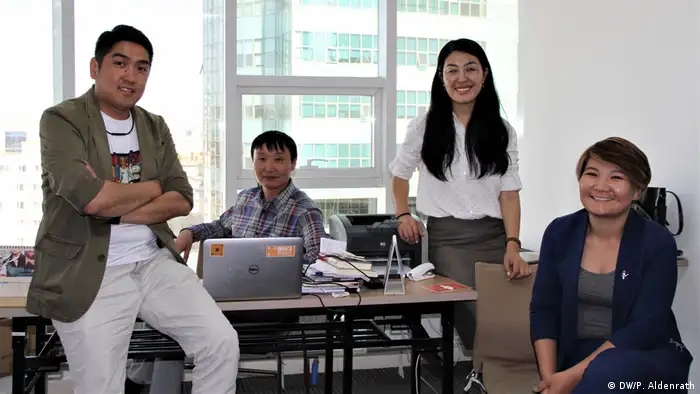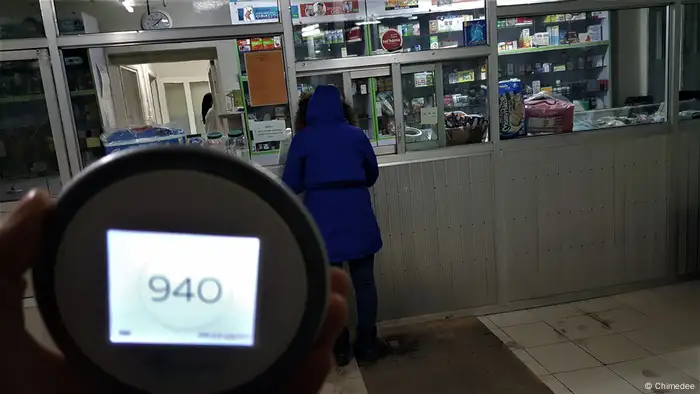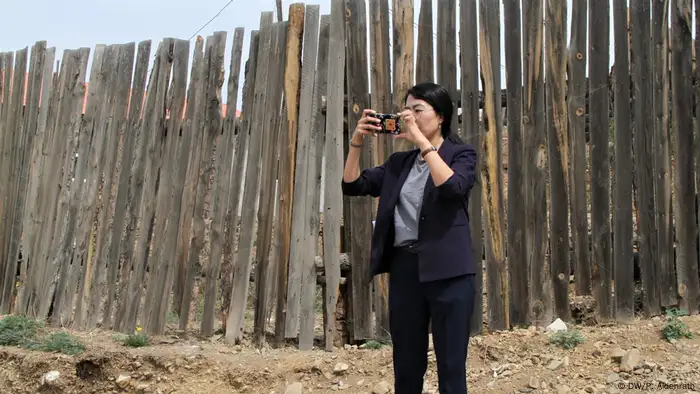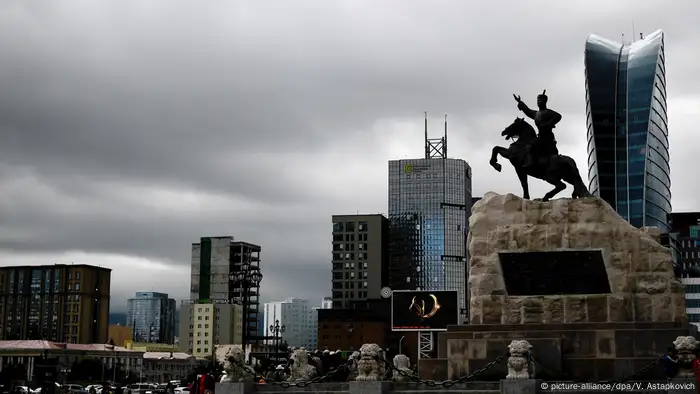our impact
When data says what politicians conceal
A group of young journalists committed to investigative reporting has joined forces to work for change in Mongolia, a country built upon a system where political, economic, and media interests are closely intertwined.

The team of the Mongolian Center for Investigative Reporters (MCIR): two men, two women — one vision
A parking spot! This is Suvda's lucky day. She maneuvers her small car into the narrow space, grabs her bag from the back seat and walks with quick steps towards the office. It took her half an hour to travel a few kilometers. Traffic is part of everyday life in the Mongolian capital Ulaanbaatar as the city's population has grown threefold in the last three decades. Many people are leaving traditionally nomadic, rural areas because they no longer see a future for themselves there. Almost half of the approximately three million Mongolians now live in this metropolis lining the Tuul River valley.
Suvda walks along the congested road, past street vendors offering roasted nuts, sugary drinks, and plastic toys. The sun radiates from a deep blue sky causing the glass facades of the city's skyscrapers to sparkle and bathing the barren mountains surrounding the city in a rich, velvety orange-yellow light. From her desk on the eleventh floor of a high-rise building, Suvda can look out over the mountains. The 33-year-old has been working for the NGO Mongolian Center for Investigative Reporters (MCIR) for a year. Suvda shares the one-room office with Amraa, Tamir, and Chimedee: two women, two men and one vision. All together they want to move Mongolian journalism towards a practice that is critical, investigative, and informative and that is no longer simply a mouthpiece for interested parties or just advertising space for companies.
Media outlets: Only 2 percent are independent
"The lack of independence is the main problem of the Mongolian media. When you open a newspaper, turn on the radio or television, or read articles online, you often don't know what advertising is, what propaganda is, and what an independent report is," said Chimedee. At 48, he is the senior member of the team.
"The media houses are often owned by members of the government who then exert direct or indirect influence," he continued, rolling up his sleeves.
Chimedee was a young man when communism ended in 1990 after a peaceful revolution and Mongolia became a democracy with a multi-party system, free elections, and an exploding media landscape.
"All told we have over 400 media outlets for a population of just three million people," he said. In 2016, the Press Institute of Mongolia listed 131 television and 98 radio stations, 101 newspapers, 86 magazines, and 98 news websites. Particularly frustrating for Chimedee is the fact that of these only about ten Mongolian media outlets operate independently. The others are paid for and controlled by those who can afford their own stake.
Chimedee started out working as a radio reporter, then he worked for a newspaper and finally published four of his own monthly and weekly papers. Having to deliver several articles a day while not earning enough to make a living is something he can relate to. That is why he is not surprised that journalists are tempted to write biased articles for a little extra money. For Chimedee himself, this was never an option. Instead, he began teaching investigative journalism as a trainer for the Press Institute of Mongolia (PIM). There he met Tamir and together they developed the idea of founding an organization that would do investigative and, above all, high-quality reporting.
The Mongolian Center for Investigative Journalism was founded in 2017. Two years later, they renamed it the Mongolian Center for Investigative Reporters (MCIR), the first entrepreneurially founded investigative center in the country. The young non-governmental organization aims to strengthen the country's democracy by promoting investigative and quality journalism. Suvda, Amraa, and Chimedee are trained journalists and Tamir is a communications expert and a fact-checker. With its range of expertise, the team aims to stand up to both nepotism and the influence of third parties on reporting in the country. To achieve this, MCIR advises Mongolian media on how to increase ratings, clicks, and sales figures with well-researched, independent reports. In addition, the MCIR team publishes investigative stories, offers training to teach journalists investigative skills and data research and is fact-checking information in the run-up to the 2020/2021 elections.
Data creates facts
From the office window, the MCIR team can not only view the mountains, but also have a look over Sukhbaatar Square. It is the heart of Ulaanbaatar's traditional and modern culture (and a popular meeting place for city dwellers). Soft ice cream is sold from a pink bus parked on the square. Children on battery-powered miniature scooters whirr past the statue of Genghis Khan, the once mighty Mongolian emperor. An office worker wearing the latest in business fashion relaxes on a bench next to a nomad woman wearing braided leather boots, a green calf-length gown, and a triangular hat. From Sukhbaatar Square, an avenue leads straight north to the outskirts of the city.
Suvda is heading there today to take pictures. She turns off the paved road onto a cobbled side street. Concrete houses are the exception here as the area is populated mostly by nomads who have imported their traditional dwelling from the dry, grassy Mongolian Steppe: round, felt covered Mongolian yurts. There is no running water so if the residents want to cook, clean, or wash up, they have to fill up canisters at the public water shed.
Over the expanse of yurts, Suvda can see the city's modern skyline including the semicircular Blue Sky Tower with its glazed façade, bulky office buildings and Parliament with its large stone columns. Suvda's camera clicks. The view is clear today. In summer, wind coming in from the steppe that surrounds the city blows the heat away. In winter the mountains and cold traps all of the city's pollution making it difficult to breathe.
"Then your eyes burn and your throat itches," said Suvda. About 60% of the inhabitants of Ulaanbaatar live in the yurt districts in the suburbs and burn coal for heating. Ulaanbaatar is not only the coldest capital in the world; it is also one of the most polluted. During the winter months, a rancid mixture of automobile exhaust fumes and coal smoke wafts through the valley basin that surrounds Ulaanbaatar.
It is a topic very familiar to Suvda. With its own data research on air pollution, MCIR landed an investigative coup in winter 2018/2019. The team noticed that the authorities published relatively good air readings even on days when dense smog lay over the city. MCIR teamed up with an environmental protection organization and carried out its own measurements for two months. Their data showed significantly worse values and found that the official measuring stations did not report all dirt particles. After MCIR put their data online, the population in the city became angry and protested. The city responded by checking their measuring stations and changing out faulty devices. Whether or not they work this time will be clear soon enough as MCIR plans to continue their own measurements.
The long road to good journalism
Robert Ritz is ecstatic over the success of MCIR's research. The data scientist moved with his Mongolian wife from the United States to Ulaanbaatar six years ago and is the director of LETU University near Sukhbaatar Square. He advised the MCIR team on the evaluation of the air measurements.
"MCIR did a really good story without pre-judging the facts. They published the measurement data in a visual way so everyone could understand them and draw their own conclusions," said Ritz.
His job at the university is to teach students how to find data, evaluate it correctly, and present it in an understandable way. For two years he has also been imparting this knowledge on Mongolian journalists. He has worked as a mentor and teacher for MCIR when the team has organized advanced training in research and investigative journalism and even a data hackathon.
"Data journalism is a challenge in Mongolia. In the USA or in Europe, visual diagrams are often developed. But in Mongolia data journalism is a new discipline. Most people here, for example, cannot read diagrams at all. In journalism training, data research is not taught," said Ritz.
Chimedee also believes that there is generally a lot of catching up to do. Again and again, he and his team advise the media in their search for suitable sources, help them build a story, and explain why it is important to interview not only officials but also the rest of the population.
"In Mongolia, too, reporters who uncover corruption and denounce social grievances are threatened," said Chimedee adding that for him, the main problem for him lies elsewhere. "We generally lack well-trained journalists."
Communists ruled Mongolia for almost 70 years and freedom of the press was a foreign concept. This has changed but there is a lack of implementation. "Our goal is to create an awareness that the population has a right to the truth and does not want to be lied to and that independent journalism and investigative stories are important for our democracy," he said.
The whole of society in view
It’s early afternoon and two blocks away from the broadcasting center of the Mongolian National Broadcaster (MNB), Batzaya Ganbat is sitting in a café ordering a cappuccino. The journalist has worked for seven years at the former state broadcaster, which is now a public service institution based on the German model. Batzayat started out as a local radio reporter but later switched to television.
"I always had the feeling that these quick reports were leading nowhere. I wanted to change something with my stories," he said.
After an advanced training course at PIM, Batzaya discovered his passion for investigative research. He learned how to cover socially relevant topics using personal stories. He now understands that the plot of a story about a homeless woman is not about her losing her home but about how unscrupulous entrepreneurs take far too much money out of her pocket to rent their market stall.
Data journalism is also on his training agenda and Batzaya has signed up for a course offered by PIM that delves into the topic.
"Data often says what politicians prefer to keep quiet. This is an important part of investigative reporting," he said.
In the meantime, Batzaya has become a renowned investigative journalist in Mongolia. When MCIR organized #HackInequality, a data hackathon, together with the DW Akademie, he and his colleagues won the competition. Their winning video was about discrimination faced by disabled children in Mongolia.
Batzaya puts down his cup of coffee. He speaks about his success quietly and casually. After the data hackathon, his head full of new ideas, he went to his boss and explained to him that the MNB needed its own investigative unit. The boss gave him the green light and he has been working as a reporter on the new three-man team since summer 2019. Batzaya—just like the reporters and trainers at MCIR—is now working to advance democracy in Mongolia through well-researched and independent journalism.
The Author: Petra Aldenrath loves to write portraits and long-form articles. She is an experienced journalist who has worked for newspapers, magazines and radio and has been published in several books. For five years she was the ARD correspondent for Mongolia and China. She has also worked as a freelance reporter from Australia, Indonesia, Vietnam, Canada and Israel. She has been working at the DW Akademie since 2018. She is particularly interested in telling the stories behind the organization's diverse media development projects.
Profile: Mongolia
Who?
- The Mongolian Center for Investigative Reporters (MCIR) is the first entrepreneurial association of investigative journalists in Mongolia.
- How does the project work?
- The Mongolian Center for Investigative Reporters develops sustainable business opportunities for independent journalism in Mongolia.
- Journalist teams and newsrooms are advised and supported in the development of innovative formats and methods (investigative, data, and mobile reporting).
- Professionalism and cooperation helps journalists in Mongolia fulfil their role as the "Fourth Estate" and uncover grievances in society, including corruption, abuse of authority, and waste of public money.
What are the difficulties?
- In Mongolia there is a close interdependence between politics, business, and the media. The roots for this lie in the former socialist system where it was common for media workers and party officials to collaborate.
- Journalists are not independently organized and are often bribed or experience direct influence by their superiors.
- Mongolia has an oversupply of media. In 2016 alone there were 131 television stations for a population of about three million people.
- Politicians and oligarchs pay media workers for uncritical reports in order to set their own agenda. The widespread image of corruption undermines the reputation of the entire media industry.
What has the project achieved?
- The population is provided with high quality and well-researched information. For example, the Mongolian Center for Investigative Reporters caused a stir in the winter of 2018/2019 with investigative research on air pollution in Ulaanbaatar. The city then replaced measuring instruments that provided incorrect data.
- The public broadcasting company, Mongolian National Broadcaster (MNB), is setting up its own investigative unit. The initiative for this came from an editor at MNB who had attended MCIR training courses.
What are the highlights?
- In 2019, MCIR and DW Akademie organized the first data hackathon in the history of Mongolia (#HackInequality) with the theme of fighting inequality.
- The MCIR team does investigations itself and as stringers for international reporters. Mongolian topics, such as air pollution in the capital Ulaanbaatar, are thus also made public outside the country.
WWW links
- Date 11.03.2020
- Feedback: Send us your feedback.
- Print Print this page
- Permalink https://p.dw.com/p/3Yofg
- Date 11.03.2020
- Send us your feedback.
- Print Print this page
- Permalink https://p.dw.com/p/3Yofg



